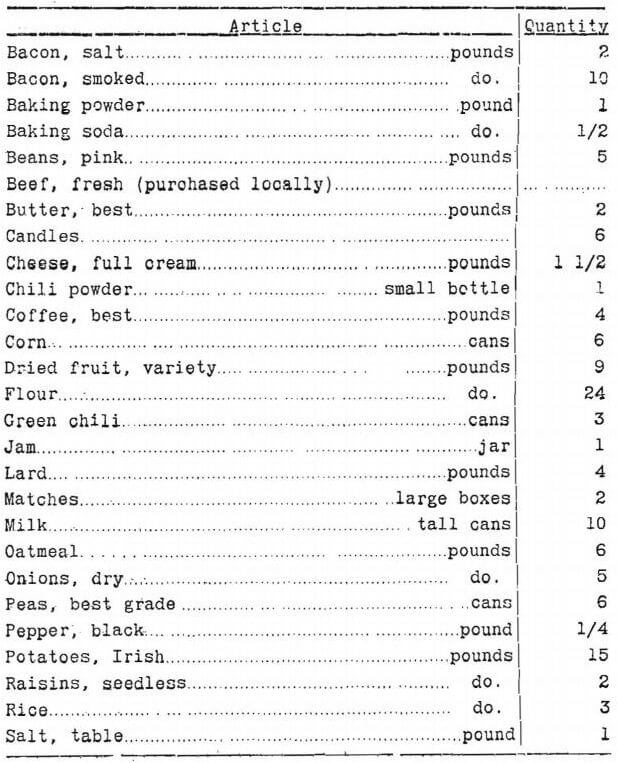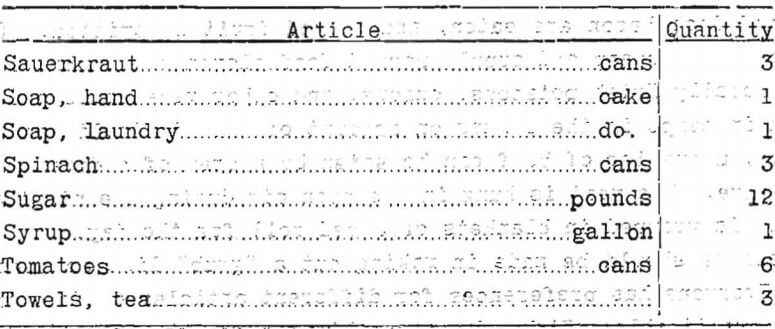Table of Contents
The outfit to be taken on a prospecting trip depends upon the mode of transportation, the work contemplated, and the funds available. Enough equipment should be taken, but unnecessary articles make extra work. When a more or less permanent camp is established, added equipment for personal comfort and efficiency can be obtained. Usually a cabin is built for a permanent camp.
Camp Outfit
Most prospectors these days use automobiles and can carry complete-camp equipment. A tent should be carried if an extended trip is to be made. Few prospectors, however, put up a tent for one night unless the weather is bad. Bedding consists of 3 or 4 blankets rolled up in canvas; the number of blankets needed depends upon the climate. A folding cot is advisable however, in a permanent camp a bunk is usually built, A full-size single-bitted ax should be carried the one-handed “Boy-Scout” ax is practically useless. A saw and a hammer with 2 or 3 pounds of assorted nails is needed in fixing up a camp and for other purposes. All prospectors and campers carry a good-quality, stout pocket knife. A miner’s acetylene lamp provides a good light; a 5-pound can of carbide will last a camp nearly all summer. A flashlight is very convenient, but an ample supply of batteries must not be overlooked.
A 50-foot length of ½- or 5/8-inch manila rope is useful for lashing the load to the car or truck, as a tent rope, for getting down into old shafts or cuts, and in making a “Spanish winch” for pulling the car out of a mudhole or for moving heavy equipment. To make this winch, one end of rope is attached to the object to be moved and the other to a tree or other anchor some distance ahead. A 5- or 6-foot length of stout sapling is held vertically or stood in a hole midway between the ends. A loop formed in the middle of the rope is placed around the end of a long pole or pipe which is used as a sweep to wind the rope around the sapling, thereby shortening the rope and pulling the object ahead.
A canvas sheet is handy to protect the load from rain, and dust. A canvas war bag is needed for clothing and other articles. A tight, stout, wooden box with a lid saves food by keeping insects and rodents away from it and is a great convenience in making and breaking camp.
A stove is necessary if a camp is to be maintained in cold weather. A combination heating and cooking stove is best, preferably one with an oven in which bread can be baked.
Camp furniture usually is improvised on the spot, the kind and amount depending upon the length of time the camp is to be used or the camper’s idea of personal comfort.
A shotgun and a few boxes of shells can be used to provide a change in diet where rabbits or game birds abound; the cost of the ammunition, however, may exceed the money value of the food thus obtained. Many prospectors living in the hills keep rifles to supply the larder with venison. A few fishhooks and a line, or even more elaborate tackle, take little room in the car and provide relaxation and food where streams contain fish. However, too much sporting equipment interferes with the purpose of a prospecting trip, and guns probably would prove a nuisance as they cannot be left unguarded in a camp without the likelihood of their being stolen.
A 2-quart canteen with shoulder strap usually is needed for carrying drinking water or water for panning. A 2-gallon canteen and a 5- or 10-gallon water keg are necessary in some districts.
Clothing
The most important item of clothing is a pair of stout, thick-soled shoes of good quality, preferably hobnailed. If an extensive trip is planned a second pair may be needed. Other clothing can be patched, but when a prospector’s shoes go to pieces his trip is ended. A pair of rubber boots will prove a comfort if much placering is done.
Woolen socks to wear under the heavy shoes help to prevent blisters; several pairs may be worn out in a season.
Other clothes are chosen for the climate and service. A leather jacket is very serviceable and comfortable in cool weather, or a sheepskin coat may be needed when it gets colder. Many prospectors in mountainous regions wear flannel shirts and woolen underwear. Overalls are a common garb.
A complete change of clothing should be taken on all except the shortest trips to permit changing into dry clothing after being caught out in the rain or working in-water all day.
Tools
A pick, a long-handled, round-pointed shovel, a gold pan, and a prospector’s pick are indispensable. If claims, are to be staked, a compass will be needed for running out the lines. A hand magnifying glass is a great help in identifying minerals. If lode deposits are to be sought a mortar and pestle, a horn spoon, or a small pan will be needed for testing rock for free gold or other heavy minerals. A blowpipe outfit and determinative tables are of service to those who can use them. Bags for taking out samples usually are needed. Double paper bags with rubber rings cut from old automobile tubes for closing the bags permit large numbers of samples to be collected with little expense for bags.
A single-jack hammer with 2 or 3 moils will come in handy for taking samples and for loosening rock encountered in making cuts.
Some prospectors carry 1 or 2 sets of hand steel and a few pounds of powder. A few rounds may be drilled and blasted before the steel has to be resharpened. If any extensive rock work is to be done a forge and a set of blacksmith tools are necessary; these usually are brought in later.
If any placering is contemplated a rocker and enough lumber to build one or two 12-inch sluice boxes may be carried.
Cooking Equipment
For a 1- or 2-man party, a frying, pan, a coffee pot, a large, and a small stew pan or pot, and a Dutch oven are needed. A knife, fork, spoon, cup, and plate are required for each man. A few extra plates come in handy. A good butcher knife, a water pail, a can opener, and a few tea towels complete the set. Other dishes can be taken according to personal preferences.
Provisions
The variety of food taken on prospecting trips depends upon the method of transportation and the prospector’s pocket book. If the supplies are to be packed on animals, bulky foods such as potatoes and canned articles are omitted. If there is need for economy in making purchases, the list will consist mostly of dried staples and vegetables if available locally.
Bacon, flour, beans, oatmeal, dried or canned fruit, coffee, syrup for hot cakes, and sugar and canned milk for the coffee are the standbys in prospectors camps. As funds get low more beans and less bacon are eaten, and canned fruit is omitted. Canned tomatoes are commonly used; they are cheap and supply needed food elements not contained in dry staples. Where available locally Irish potatoes, onions, and other vegetables are eaten. Fresh meat is not used much in camps in the summer on account of the difficulty of keeping it, In dry climates, however, a quarter- of beef can be eaten by a crew of a dozen men before it spoils by using proper care. The meat is hung in the open air during the night and in the morning, while still cool, is wrapped in blankets or a bed roll for the day.
A proper balance should be made in making out a “grub” list so that needed items will not run short. Everyone has preferences for different articles of food which should be followed as much as practicable, It has been found by experience, however, that fancy groceries are the ones left over and the first articles to be used are the bacon, potatoes, and flour. Plain, wholesome fare seems to be preferred in camp, especially where hard work is done.
The old United States army ration for one man for 1 day was: 12 ounces bacon or pork, or 22 ounces fresh beef; 18 ounces soft bread or flour, or 16 ounces hard bread, or 20 ounces corn meal.
For each 30 rations the following items were issued: 5 pounds beans or peas, or 10 pounds rice; 5 pounds sugar; 1 quart vinegar; ¼ pound hard candy; 1 pound soap; 1½ pounds salt; and 1¼ ounces pepper.
The following standard ration list for fireguards is used as a guide by the Forest Service. The articles listed are enough for one man for 30 days.


The following weekly allowance of food for one person to give a balanced diet is condensed from suggestions made by Doctor Smith: Three 1-pound cans evaporated milk; 2 pounds potatoes; 4 pounds onions, cabbage, beets, or other vegetables; 3 pounds citrus fruits, or 6 pounds fresh apples, or equivalent dried prunes, apricots, etc., 3 pounds dried beans; 6 to 8 pounds cereals, whole-wheat flour or bread, rolled oats, shredded wheat, etc.; 2½ pounds dried meat, bacon, ham, or cheese (fresh meat or eggs may be substituted if available); 3 pounds sugar 1 pound coffee; ¼ pound salt; ½-pound butter; and baking powder.
In many districts of the Southwest water must be carried. The quantity required depends upon the time of year and the amount of work done by the miner. Men working where temperatures range from 100° to 110° drink 2 gallons or more of water per day; under such conditions, a 10-gallon tank would last one man 3 days, allowing for cooking but not for the radiator of the car. In cooler weather a 10-gallon tank should last one man a week or 10 days.
First-Aid Supplies
As prospectors are likely to be away from medical aid, some medical and first-aid supplies should be taken along. These should consist of a laxative (castor oil or salts), iodine or mercurochrome to disinfect cuts or bruises, and a first-aid kit. A snake-bite kit may also prove invaluable.
Related: Blacksmith Hammer
